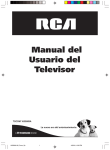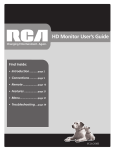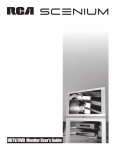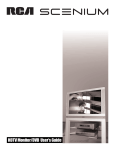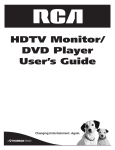Download RCA scenium Flat Panel Television User Manual
Transcript
HDTV Monitor User’s Guide Downloaded from www.Manualslib.com manuals search engine Important Information WARNING To reduce the risk of fire or electric shock, do not expose this product to rain or moisture. CAUTION Caution: To reduce the risk of electric shock, do not remove cover (or RISK OF ELECTRIC SHOCK DO back). No user serviceable parts inside. Refer servicing to qualified service personnel. NOT OPEN This symbol indicates "dangerous voltage" inside the product that presents a risk of electric shock or personal injury. This symbol indicates important instructions accompanying the product. The apparatus shall not be exposed to dripping or splashing and that no objects filled with liquids, such as vases, shall be placed on the apparatus. Refer to the identification/rating label located on the back panel of your product for its proper operating voltage. FCC Regulations state that unauthorized changes or modifications to this equipment may void the user’s authority to operate it. Caution: Using video games or any external accessory with fixed images for extended periods of time can cause them to be permanently imprinted on the picture tube (or projection TV picture tubes). ALSO, some network/program logos, phone numbers, black borders (sides, top and bottom), etc. may cause similar damage. This damage is not covered by your warranty. Cable TV Installer: This reminder is provided to call your attention to Article 820-40 of the National Electrical Code (Section 54 of the Canadian Electrical Code, Part 1) which provides guidelines for proper grounding and, in particular, specifies that the cable ground shall be connected to the grounding system of the building as close to the point of cable entry as practical. Warning: Do not use the Freeze feature for an extended period of time. This can cause the image to be permanently imprinted on the picture tube. Such damage is not covered by your warranty. Press any button to unfreeze the picture at any time. Product Registration Please fill out the product registration card (packed separately) and return it immediately. Returning the card allows us to contact you if needed. Product Information Keep your sales receipt to obtain warranty parts and service and for proof of purchase. Attach it here and record the serial and model numbers in case you need them. These numbers are located on the product. Model No. ____________________________________________________________________________________________________________________ Serial No. _____________________________________________________________________________________________________________________ Purchase Date: ________________________________________________________________________________________________________________ Dealer/Address/Phone: __________________________________________________________________________________________________________ Downloaded from www.Manualslib.com manuals search engine Important Information IMPORTANT SAFETY INSTRUCTIONS 1. Read these instructions. 2. Keep these instructions. 3. Heed all warnings. 4. Follow all instructions. 5. Do not use this apparatus near water. 6. Clean only with dry cloth. 7. Do not block any ventilation openings. Install in accordance with the manufacturer’s instructions. 8. Do not install near any heat sources such as radiators, heat registers, stoves, or other apparatus (including amplifiers) that produce heat. 9. Do not defeat the safety purpose of the polarized or grounding-type plug. A polarized plug has two blades with one wider than the other. A grounding type plug has two blades and a third grounding prong. The wide blade or the third prong is provided for your safety. If the provided plug does not fit into your outlet, consult an electrician for replacement of the obsolete outlet. 10. Protect the power cord from being walked on or pinched particularly at plugs, convenience receptacles, and the point where they exit from the apparatus. 11. Only use attachments/accessories specified by the manufacturer. 12. Use only with the cart, stand, tripod, bracket, or table specified by the manufacturer, or sold with the apparatus. When a cart is used, use caution when moving the cart/apparatus combination to avoid injury from tip-over. 13. Unplug this apparatus during lightning storms or when unused for long periods of time. 14. Refer all servicing to qualified service personnel. Servicing is required when the apparatus has been damaged in any way, such as power-supply cord or plug is damaged, liquid has been spilled or objects have fallen into the apparatus, the apparatus has been exposed to rain or moisture, does not operate normally, or has been dropped. If an outside antenna is connected to the TV receiver, be sure the antenna system is grounded so as to provide some protection against voltage surges and built up static charges. In the U.S. Section 810-21 of the National Electrical Code and in Canada, Part 1 of the Canadian Electrical Code provides information with respect to proper grounding of the antenna system. See the figure on the right for details. Example of Antenna Grounding as per (NEC) National Electrical Code ANTENNA LEAD IN WIRE GROUND CLAMP ANTENNA DISCHARGE UNIT (NEC SECTION 810-20) GROUNDING CONDUCTORS (NEC SECTION 810-21) GROUND CLAMPS ELECTRIC SERVICE EQUIPMENT POWER SERVICE GROUNDING ELECTRODE SYSTEM (NEC ART 250, PART H) To assure adequate ventilation for this product, maintain a spacing of 4 inches from the top and sides of the TV receiver and 2 inches from the rear of the TV receiver and other surfaces. 1 Downloaded from www.Manualslib.com manuals search engine Introduction Key Features Overview Your TV is equipped with features that will add to your TV viewing experience. The following information summarizes a few of these features. Chapter 3 provides more information about the rest of the TV’s features and how to use them. DVI-HDTV Input Lets you connect an HD receiver with a DVI output. L/MONO • DVI-HDTV R DVI (Digital Visual Interface) Provides an uncompressed, digital video interface developed for high-bandwidth digital connection. It supports the overlay of high-resolution graphics needed by some electronic program guide navigation and other interactive services. DVI, when combined with HDCP (High bandwidth Digital Content Protection) technology, creates a protected digital connection. The signal speed of the DVI connection is 1080i for HDTV at a rate of 1.78 Gigabits per second. Dolby* Virtual Available only for stereo signals. Creates a virtualized surround sound experience from two speakers using the Dolby Pro Logic decoding. It provides the sensation of being surrounded by additional speakers. PIP (Picture-In-Picture) and POP (Picture-Outside-Picture) Description: PIP lets you watch two channels at one time — one channel on the main screen and the other in a smaller window. POP also lets you watch two channels at one time- one channel on the left side of the screen (the main picture) and the other on the right. PIP example Requirements: Press the PIP button to bring up the PIP window. Press again to bring up POP. Chapter 3 has detailed instructions on how to use the PIP and POP features. POP example Auto Tuning Description: Allows you to set up the TV to automatically tune to a specific channel when you press a certain component (VCR, DVD player, etc.) button on the remote. Requirements: Set up Auto Tuning in the TV’s menu system. (Chapter 3 has details). V-Chip: Parental Controls Description: You can block programs and movies by content, age-based ratings, and/or movie ratings. Requirements: • Set up the Parental Control menu in the TV’s main menu (Chapter 3 has details). • The broadcasters must use the rating system when they send the program to your TV in order for your TV to block the program. • Parental controls must be locked for these settings to take affect. * Dolby is a trademark of Dolby Laboratories 2 Downloaded from www.Manualslib.com manuals search engine Table of Contents IMPORTANT SAFETY INSTRUCTIONS ....................... 1 Introduction Key Features Overview............................................... 2 DVI-HDTV Input ............................................. 2 Dolby* Virtual ................................................... 2 PIP (Picture-In-Picture) and POP (Picture-Outside-Picture) ................................ 2 Auto Tuning ...................................................... 2 V-Chip: Parental Controls ................................. 2 Chapter 1: Connections and Setup Things to Consider Before You Connect .................. 4 Protect Against Power Surges .......................... 4 Protect Components from Overheating .......... 4 Position Cables Properly to Avoid Audio Interference ..................................................... 4 Important Stand and Base Safety Information ..................................................... 4 Use Indirect Light .............................................. 4 Cables Needed to Connect Components to Your TV ............................................................ 4 Choose Your Connection ............................................ 5 TV + HD Receiver + VCR + DVD Player .................... 6 TV + Satellite Receiver + VCR .................................. 7 TV + DVD + VCR ......................................................... 8 TV+ A/V Receiver or Speakers .................................. 9 Explanation of Jacks ................................................ 10 The Front of Your TV ............................................... 11 Front Inputs ..................................................... 11 Front Panel Buttons ........................................ 11 Plug in the TV ........................................................... 11 Put batteries in the remote..................................... 11 How to Use the Remote Control to Complete the Initial Setup .............................................................. 11 Turn on the TV .......................................................... 11 Complete the Initial Setup ...................................... 11 Set the Menu Language ................................. 12 Complete Auto Channel Search ..................... 12 Changing Lists and Labels .............................. 12 Auto Convergence .......................................... 12 Find Out If You Need to Program the Remote .......................................................... 14 Programming the Remote .............................. 14 How to Use the Remote After You’ve Programmed It .............................................. 15 Remote Control Codes ............................................. 15 Chapter 3: Using the TV’s Features Channel Banner ........................................................ 17 Why You Should Use the Autotuning Feature ...... 17 How to Set Up the Autotuning Feature ........ 17 Parental Controls and V-Chip ................................. 18 How V-Chip Works .......................................... 18 V-Chip TV Rating ............................................. 19 Blocking Specific Content Themes ................. 20 Viewing Specific Content Themes.................. 20 V-Chip Movie Rating Limit ............................. 20 V-Chip Unrated Program Block ...................... 21 Lock/Unlock Parental Controls ....................... 21 Front Panel Block ............................................ 21 PIP (Picture-in-Picture) and POP (Picture-outside-Picture) Operation ................... 21 PIP and POP Buttons ....................................... 21 Chapter 4: Using the TV’s Menu System Sound Menu.............................................................. 22 Picture Menu ............................................................ 23 Channel Guide Menu ............................................... 23 Time Menu ................................................................ 24 Parental Control Menu ............................................ 24 PIP Menu ................................................................... 24 Setup Menu .............................................................. 24 Chapter 5: Other Information Troubleshooting ........................................................ 26 Care and Cleaning .................................................... 27 Limited Warranty ..................................................... 28 Accessories ................................................................ 29 Chapter 2: Using the Remote Control The Buttons on the Remote Control ...................... 13 Using the INPUT Button ................................. 14 Programming the Remote to Operate Other Components ............................................................ 14 3 Downloaded from www.Manualslib.com manuals search engine Connections & Setup Things to Consider Before You Connect Protect Against Power Surges • Connect all components before you plug any of their power cords into the wall outlet. • Turn off the TV and/or component before you connect or disconnect any cables. • Make sure all antennas and cables are properly grounded. Refer to the Important Safety Instructions on page 1. Protect Components from Overheating • Don’t block ventilation holes on any of the components. Arrange the components so that air can circulate freely. • Don’t stack components. • When you place components in a stand, make sure you allow adequate ventilation. • If you connect an audio receiver or amplifier, place it on the top shelf so the heated air from it won’t flow around other components. Position Cables Properly to Avoid Audio Interference • Insert each cable firmly into the designated jack. • If you place components above the TV, route all cables down the side of the back of the TV instead of straight down the middle of the TV. • If your antenna uses 300-ohm twin lead cables, do not coil the cables. Also, keep the twin lead cables away from audio/video cables. Important Stand and Base Safety Information Choose the location for your TV carefully. Place the TV on a stand or base that is of adequate size and strength to prevent the TV from being accidentally tipped over, pushed off, or pulled off. This could cause personal injury and/ or damage the TV. Refer to the Important Safety Instructions on page 1. Use Indirect Light Don’t place the TV where sunlight or room lighting will be directed toward the screen. Use soft or indirect lighting. Cables Needed to Connect Components to Your TV The pictures below show the cables needed for the connections represented in this book. Audio/Video cables 4 Coaxial cable S-Video cable Component Video (Y•Pb•Pr) cables Graphics contained within this publication are for representation only. Downloaded from www.Manualslib.com manuals search engine Chapter 1 Connections & Setup Choose Your Connection There are several ways to connect your TV. Please use the following chart to determine which connection is best for you. Proceed to the appropriate page and connect your TV. Note: If you prefer, we can provide you with the name of an Authorized Service Representative who will visit your home for a fee to install your electronic entertainment system and to instruct you in its operation. For details about this service, call 1-888-206-3359. Components Cables Needed Connection Title Go to... Coaxial Audio/video TV HD iver e Rec DVD VCR Component video TV + HD Receiver + DVD + VCR page 6 TV + Satellite Receiver + VCR page 7 TV + DVD + VCR page 8 Coaxial Audio/video TV VCR lite tel Sa S-Video Coaxial Audio/video TV DVD VCR Component video For general information on connecting an A/V receiver or speakers to your TV, go to page 9. Chapter 1 Graphics contained within this publication are for representation only. Downloaded from www.Manualslib.com manuals search engine 5 Connections & Setup CABLE O R OFF-AIR ANTENNA TV HD RECEIVER 1A S-VIDEO ANT IN DVD PLAYER VIDEO R AUDIO L PR PB Y L R AUDIO OUT R L ANT OUT L PR PB Y PB R PR S-VIDEO R SAT IN HD iver e Rec Y 1B 2A 2B 3B Satellite Receiver L/MONO 5B CMP1 L/MONO R PR PB Y 5A TV DVI-HDTV PB Y L/MONO R PR CMP2 R EXT/INT COMPONENT INPUTS + + RIGHT LEFT EXTERNAL SPEAKERS COMPOSITE INPUTS L/MONO V VID2 S-VIDEO AUDIO/VIDEO OUTPUT R VID1 3C S-VIDEO 3A DVD L/MONO V V ANTENNA/ CABLE R SUBWOOFER 4C VCR VIDEO VCR L AUDIO R FIXED AUDIO R L VARIABLE AUDIO L R 4A 4B IN OUT VIDEO ANTENNA IN L AUDIO R ANTENNA OUT TV + HD Receiver + VCR + DVD Player 1. Make sure cable or antenna and/or satellite is connected to your VCR. A. Connect the coaxial cable from your cable outlet or antenna to the antenna input on the HD Receiver. B. Connect the satellite dish antenna to the satellite input on the HD Receiver. 2. Connect your HD Receiver to your TV. A. Connect the audio (white and red) cables to the CMP1 L/MONO and R audio jacks on the back of the TV and to the Audio Output jacks on the HD Receiver. B. Connect three video grade cables to the CMP1 Y, PB, PR jacks on the back of the TV and to the Y, PB, PR jacks on the HD Receiver. Notes: The Y, PB, PR jacks are sending the digital cable signal to the TV. If your HD Receiver has a DVI output, connect the HD Receiver to your TV using a DVI cable. Make sure to connect the left and right audio cables to the DVI L/MONO and R jacks on the TV. 3. Connect your HD Receiver to your VCR. A. Connect a coaxial cable to the HD Receiver’s antenna output and to VCR’s antenna input. B. Connect the audio (white and red) cables to the Audio Output jacks on the HD Receiver and to the Audio Input jacks on the VCR. C. Connect the video cable to the Video Output jack on the HD Receiver and to the Video Input jack on the VCR. 4. Connect your VCR to your TV. A. Connect a coaxial cable to the VCR’s antenna output and to the ANTENNA/CABLE Input jack on the TV. B. Connect the audio (white and red) cables to the VID2 L/MONO and R audio jacks on the back of the TV and to the Audio Output jacks on the VCR. C. Connect the video cable to the VID2 V (video) jack on the back of the TV and to the Video Output jack on the VCR. 5. Connect your DVD player to your TV. A. Connect the audio (white and red) cables to the CMP2 L/MONO and R audio jacks on the back of the TV and to the Audio Output jacks on the DVD player. B. Connect three video grade cables to the CMP2 Y, PB, PR jacks on the back of the TV and to the Y, PB, PR jacks on the DVD player. Notes: If your DVD player doesn’t have Y, PB, PR jacks, but does have an S-Video jack, connect the player to the TV’s VID1 S-VIDEO jack using an S-Video cable. If your DVD player doesn’t have an S-Video jack, connect the player to the TV’s VID1 V (video) jack using a video cable. Important: If you use the TV’s VID1 S-VIDEO or V (video) jack to connect the DVD player, you must connect the audio cables to the TV’s VID1 L/MONO and R jacks. Go to page 12 6 Graphics contained within this publication are for representation only. Downloaded from www.Manualslib.com manuals search engine Chapter 1 Connections & Setup SATELLITE RECEIVER VIDEO S-VIDEO AUDIO L R TV 3C PB Y PR L/MONO R 3A DVI-HDTV Y 3B PB PR L/MONO R HDTV MONITOR CMP2 R CMP1 L/MONO EXT/INT COMPONENT INPUTS + + RIGHT LEFT EXTERNAL SPEAKERS L/MONO R AUDIO/VIDEO OUTPUT V L/MONO FIXED AUDIO R L V ANTENNA/ CABLE VID2 S-VIDEO V VID1 Sa tel S-VIDEO COMPOSITE INPUTS lite VARIABLE AUDIO R SUBWOOFER L 1A 1B 1C VCR VCR CABLE R VIDEO L AUDIO R IN L O OUT O R VIDEO ANTENNA IN L AUDIO R ANTENNA OUT OFF-AIR ANTENNA 2 TV + Satellite Receiver + VCR 1. Connect your VCR to your TV. A. Connect a coaxial cable to the VCR’s antenna output and to the ANTENNA/CABLE Input jack on the TV. B. Connect the audio (white and red) cables to the VID2 L/MONO and R Audio jacks on the back of the TV and to the Audio Output jacks on the VCR. C. Connect the video cable to the VID2 V (Video) jack on the back of the TV and to the Video Output jack on the VCR. 2. Make sure cable or antenna is connected to your VCR. Connect the coaxial cable from your cable outlet or antenna to the antenna input on the VCR. 3. Connect your Satellite Receiver to your TV. A. Connect the audio (white and red) cables to the VID1 L/MONO and R Audio jacks on the back of the TV and to the Audio Output jacks on the Satellite Receiver. B. Connect the video cable to the VID1 V (Video) jack on the back of the TV and to the Video Output jack on the Satellite Receiver. C. If your Satellite Receiver has an S-Video jack, connect an S-Video cable (instead of the video cable in step B) to the S-VIDEO jack on the TV and to the S-VIDEO jack on the satellite receiver. Go to page 12 Chapter 1 Graphics contained within this publication are for representation only. Downloaded from www.Manualslib.com manuals search engine 7 Connections & Setup DVD Player Y PB PR L AUDIO R S-VIDEO TV 1A 1B PR L/MONO R R CMP2 PB CMP1 Y L/MONO HDTV MONITOR DVI-HDTV Y DVD PB PR L/MONO R EXT/INT COMPONENT INPUTS + + RIGHT LEFT EXTERNAL SPEAKERS L/MONO R AUDIO/VIDEO OUTPUT V VCR L/MONO ANTENNA/ CABLE VARIABLE AUDIO R 2C FIXED AUDIO R L V VID2 S-VIDEO V VID1 S-VIDEO COMPOSITE INPUTS SUBWOOFER L 2A 2B VCR CABLE R VIDEO L AUDIO R IN L O OUT O R VIDEO ANTENNA IN L AUDIO R ANTENNA OUT OFF-AIR ANTENNA 3 TV + DVD + VCR 1. Connect your DVD Player to your TV. A. Connect the audio (white and red) cables to the CMP1 L/MONO and R Audio jacks on the back of the TV and to the Audio Output jacks on the DVD player. B. Connect three video grade cables to the CMP1 Y, PB, PR jacks on the back of the TV and to the Y, PB, PR jacks on the DVD player. Notes: If your DVD player does not have Y, PB, PR jacks, but does have an S-Video jack, connect the player to the VID1 S-VIDEO jack on the TV using an S-Video cable. If your DVD player does not have an S-Video jack, connect the player to the VID1 V (Video) jack on the back of the TV using a video cable. Important: If you use the VID1 S-VIDEO or V (Video) jack to connect your TV to the DVD player, you must connect the audio cables to the VID1 L/MONO and R jacks on the TV. 2. Connect your VCR to your TV. A. Connect a coaxial cable to the VCR’s antenna output and to the ANTENNA/CABLE Input jack on the TV. B. Connect the audio (white and red) cables to the VID2 L/MONO and R Audio jacks on the back of the TV and to the Audio Output jacks on the VCR. C. Connect the video cable to the VID2 V (Video) jack on the back of the TV and to the Video Output jack on the VCR. 3. Make sure cable or antenna is connected to your VCR. Connect the coaxial cable from your cable outlet or antenna to the antenna input on the VCR. Go to page 12 8 Graphics contained within this publication are for representation only. Downloaded from www.Manualslib.com manuals search engine Chapter 1 Connections & Setup TV+ A/V Receiver or Speakers These are two different ways your TV uses a component to hear audio. 1. Connect audio cables to either the FIXED or VARIABLE AUDIO L and R OUTPUT jacks and to the Audio Inputs on the A/V receiver. • FIXED provides fixed-level audio output from the TV. This audio output is ideal for connecting to an A/V receiver that has its own volume control. • VARIABLE provides variable-level audio output. Volume levels can be controlled by the volume controls on the TV and TV remote control. -OR- 2. Use speaker wire to connect the TV to external speakers. • The EXT/INT switch beside the jacks let you turn the TV’s internal speakers on or off. If you connect external speakers, slide the switch to EXT so the audio is sent to the external speakers only. Choosing INT sends the audio to the TV’s speakers only. Note: The external speaker rating is 8 ohms with 15 watts power handling capabilities. A/V RECEIVER CD IN TV IN TAPE IN OUT VCR IN OUT R L Connect to either FIXED or VARIABLE Output 1 PB PR L/MONO R PB PR L/MONO R TV CMP1 Y L/MONO DVI-HDTV Y CMP2 R EXT/INT COMPONENT INPUTS + + RIGHT LEFT EXTERNAL SPEAKERS L/MONO R AUDIO/VIDEO OUTPUT VID2 S-VIDEO V VID1 S-VIDEO COMPOSITE INPUTS V L/MONO V ANTENNA/ CABLE R FIXED AUDIO R L VARIABLE AUDIO SUBWOOFER L R 2 Chapter 1 Graphics contained within this publication are for representation only. Downloaded from www.Manualslib.com manuals search engine 9 Connections & Setup Explanation of Jacks This section describes the jacks you can use to make connections. There are several ways to connect components to your TV. DVI-HDTV Input Lets you connect an HD receiver with a DVI output. • DVI (Digital Visual Interface) Provides an uncompressed, digital video interface developed for high-bandwidth digital connection. It supports the overlay of high-resolution graphics needed by some electronic program guide navigation and other interactive services. DVI, when combined with HDCP (High bandwidth Digital Content Protection) technology, creates a protected digital connection. The signal speed of the DVI connection is 1080i for HDTV at a rate of 1.78 Gigabits per second. • L/MONO (Audio) Provides left audio connection when using the DVI jack. The left audio connector is usually white. • R (Audio) Provides right audio connection when using the DVI jack. The right audio connector is usually red. L/MONO DVI-HDTV R Note: Remember to connect the left and right audio cables because the DVI cable carries only the picture signal, not the sound. COMPONENT INPUTS PR L/MONO R Y PB PR L/MONO R CMP2 PB CMP1 Y COMPONENT INPUTS S-VIDEO S-VIDEO V L/MONO R VID2 R VID1 L/MONO CMP1 Y, PB, PR (Component Video) Provides optimum picture quality because the video is separated into three signals. Use three video-grade cables for the connection. When using CMP1 Y, PB, PR, make sure to connect left and right audio cables to the CMP1 L/MONO and R Audio Input jacks. • CMP1 L/MONO (Audio) Provides left audio connection. The left audio connector is usually white. • CMP1 R (Audio) • CMP2 Y, PB, PR, and L/MONO and R Audio Allows you to connect a second component video source. Their description is the same as CMP1 above. When using CMP2 Y, PB, PR, make sure you connect the left and right audio cables to the CMP2 Audio jacks. Provides right audio connection. The right audio connector is usually red. COMPOSITE INPUTS Lets you connect another component such as a VCR, DVD player, or laserdisc player. Its AUDIO jacks are the same as described for CMP1 above. COMPOSITE INPUTS V Lets you connect a component video source, such as a DVD player. • • VID1 S-VIDEO Provides better picture quality than the video jacks (VID1 and 2 Video) because the color part of the signal is separated from the black and white part of the picture. When using VID1 S-VIDEO, make sure to connect left and right audio cables to the VID1 L/ MONO and R Audio Input jacks. • VID1 V (Video) Provides composite video connection. The video connector is usually yellow. • VID2 S-VIDEO, V and L/MONO and R Audio Allows you to connect a component such as a VCR, DVD player, or laserdisc player. Their description is the same as VID1 above. Note: Do not connect an S-Video and Video cable at the same time in either VID1 or VID2 jacks. AUDIO/VIDEO OUTPUTS Lets you connect an amplifier or audio receiver for improved sound quality or an external video monitor. AUDIO/VIDEO OUTPUT V FIXED AUDIO R L VARIABLE AUDIO SUBWOOFER L • FIXED AUDIO L/R Provides fixed-level audio output from the TV. This audio output is ideal for connecting to an A/V receiver when you want to control the volume through the A/V receiver. • VARIABLE AUDIO Provides variable-level audio output. Volume levels are controlled by the volume controls on the TV and remote control. • SUBWOOFER Provides lower bass audio frequencies out from the TV and to a subwoofer. R Note: If you’ve connected a subwoofer, make sure you set the External Subwoofer option in the Sound menu. Go to page 22 for instructions. EXTERNAL SPEAKERS EXT/INT + + RIGHT LEFT • Right and Left Speaker Terminals TV to receive left and right sound. Let you connect external left and right speakers to the • EXT/INT (switch) Lets you turn the TV’s internal speakers on or off. EXT sends audio to external speakers only. INT sends audio to the TV’s internal speakers only. ANTENNA/CABLE Lets you connect a coaxial cable to receive the signal from the antenna, cable, cable box, or if using the examples on pages 6-8, a VCR. EXTERNAL SPEAKERS 10 Graphics contained within this publication are for representation only. Downloaded from www.Manualslib.com manuals search engine Chapter 1 Connections & Setup The Front of Your TV Front Inputs The TV has front inputs for convenience: one set of audio/video inputs, an S-Video and a headphone jack. Locate the jacks either on the front of the TV or on one of the sides. You can access the component you connected to the front of the TV by pressing the INPUT button on your remote until FRNT appears on the screen. The jacks are ideal for using a video game console or a camcorder. Note: When connecting a device that uses a monaural cable, such as some camcorders, use the Left (mono) input jack to get sound from both speakers. PHONES Allows you to connect headphones to listen to the sound coming from the TV. To adjust volume control of the headphones, press the VOL > or VOL < button (the volume display appears). Press the arrow up or down button (the headphone volume display appears), then press the right or left arrow button to adjust the headphone volume. VIDEO (in) Receives video from another component such as a VCR, camcorder or video game console. L/MONO and R AUDIO Receives audio from another component such as a VCR, camcorder or video game console. S-VIDEO (in) Allows you to connect an S-Video cable from another component. Make sure you also connect audio cables from the component to the TV. Front Panel Buttons If you cannot locate your remote, you can use the front panel buttons of your TV to operate many of the TV’s features. MENU/OK Brings up the Main menu. In the menu system, it selects highlighted items. CH v Scans down through the current channel list. In the menu system, acts like down arrow button on the remote control and adjusts menu controls. CH Scans up through the channel list. In the menu system, acts like up arrow button on the remote control and adjusts menu controls. v VOL < Decreases the volume. In the menu system, acts like left arrow button on the remote control and adjusts menu controls. VOL > Increases the volume. In the menu system, acts like right arrow button on the remote control and adjusts menu controls. POWER Turns the TV on and off. Plug in the TV Plug the end of the power cord into a grounded wall outlet. Insert the plug completely into the outlet. Put batteries in the remote • Remove the battery compartment cover from the back of the remote by pushing down on and sliding off the cover. • Insert 2 “AA” fresh batteries. Make sure the polarities (+ and -) are aligned correctly. • Replace the cover. How to Use the Remote Control to Complete the Initial Setup ON OFF VCR1 DVD AUX VCR2 MUTE The technical term is “Navigation” – how you move through the on-screen menus. The theory is the same throughout the menu screens: highlight your choice and select it. TV SAT CABLE SKIP To highlight a menu item, press the arrow buttons on the remote to highlight one of the items listed on the screen. Use the up or down arrow button to move up or down. Use the right or left TV button arrow button to move right or left. CH + To select the item that you’ve highlighted, press OK. VOL VOL Note: Highlighted means that the menu item stands out from other menu items on the list (appears darker, brighter, or a different color). CH - GUIDE GO BACK DISC MENU INFO Turn on the TV ZO Press TV on the remote, or press POWER on the TV’s front panel. - OM ZO OK OM + FREEZE Arrows Note: Pressing the TV button not only turns on the TV, but puts the remote into TV mode. “TV mode” means that the buttons on the remote control operate the TV’s functions. Tip Complete the Initial Setup To access the setup menus manually, press MENU and choose SETUP. The menu system in your TV allows the TV’s features to work properly. The first time you turn on your TV, the setup screens appear. Chapter 1 Graphics contained within this publication are for representation only. Downloaded from www.Manualslib.com manuals search engine 11 Connections & Setup Set the Menu Language The first part of the setup allows you to select your preferred language for the menu system. 1. Highlight your preferred language for the menu system using the arrow buttons. 2. Press OK to select that language (the Channel Setup screen appears with Auto channel search highlighted). Complete Auto Channel Search This part of the setup allows the TV to search for all channels viewable through your antenna or cable TV system. This is sometimes called auto programming. Press OK to begin auto channel search. When the channel search is complete, press OK to access the List & Labels screen. Changing Lists and Labels The List & Labels part of the setup lets you edit your channel list and choose or create a personal six-character label for each channel. Note: Changing List and Labels can be time consuming. You can change these at a later time by accessing the Setup menu. 1. Press the left or right arrow to scroll through the available channels and choose the channel you want to edit. 2. Press the down arrow to highlight the In channel list option. Press the left or right arrow button to add (the box is checked) or remove (the box is unchecked) the channel from the list. 3. Press the down arrow to highlight the Channel label option. Press the left or right arrow button to scroll through the available list of 25 most common labels. The last option in the list allows you to create your own six-character label for the channel (the first letter of the label is highlighted). 4. Press the 1 or 2 number button to change the first letter of the label. 5. Press the right arrow to highlight the second letter, then press the 1 or 2 number button to change the second letter, etc... 6. When you are finished creating your label, highlight Go Back (the Auto Convergence menu appears). Auto Convergence Your TV’s picture tubes might have been disturbed during delivery or after you moved the TV, causing the color in your TV to be out of alignment. The colors adjust by starting auto convergence. 1. Press OK to begin auto convergence. 2. When the auto convergence is complete, the Red center convergence menu appears. The cross in the middle of the screen should be yellow. If it is not, use the arrow buttons to move the red cross to overlap the green cross. Press OK when adjustments are complete. 3. The Blue center convergence menu appears with a cyan cross in the middle of the screen. If it is not, use the arrow buttons to move the blue cross to overlap the green cross. Press OK (the TV tunes to the last available channel in the channel list). 12 Graphics contained within this publication are for representation only. Downloaded from www.Manualslib.com manuals search engine Chapter 1 Using the Remote Control The Buttons on the Remote Control ON OFF VCR1 DVD Indicator TV SAT CABLE AUX VCR2 MUTE SKIP VOL VOL Backlight Lights up some of the buttons in the dark. GUIDE GO BACK DISC MENU INFO ZO OK CLEAR 1 2 3 4 5 6 7 8 9 RECORD SOUND ANT PIP FORWARD STOP SWAP DVD Puts the remote in DVD mode and, if Autotuning is enabled, will turn on the TV and tune to the correct input channel. FREEZE When watching TV, freezes the picture until you press another button to resume normal TV viewing. 0 PLAY CLEAR Removes any menu or display from the screen and returns you to normal viewing. DISC MENU No function available in TV mode. If operating an RCA, a GE or Proscan DVD player, for example, brings up the Disc menu. MENU REVERSE CH + or CH - Scans up or down through the current channel list. Press once to change the channel up or down; press and hold to continue changing channels. CH+ or CH- PIP When using PIP or POP, changes the channel in the picture window. OM + FREEZE INPUT To enter a one-digit channel, enter a zero first. To enter a two-digit channel, press the two digits. To enter a three-digit channel, press and hold the “1” button until “1” and two dashes (– –) appear, then add the second two digits. Example: to tune to channel 123, press and hold 1 until “1– –” appears, release the 1 button and then press 2 and 3. AUX Puts the remote in AUX mode. Can also be programmed to operate most brands of an additional remote-controllable component. CH - Z Enter channel numbers and time settings directly through the remote Arrows Used to point to different items in the TV menu and to adjust the menu controls. Moves the PIP window when no menus are on the screen. Also switches the two POP windows when no menus are on the screen. For Zoom use, go to next page. CH + MOO (0-9) Number Buttons control. PAUSE CH - CH + Note: Do not use the Freeze feature for an extended period of time. This can cause the image to be permanently imprinted on the picture tube. Such damage is not covered by your warranty. Press any button to unfreeze the picture at any time. GO BACK Returns you to the previous channel. GUIDE Brings up the Channel Guide menu. INDICATOR Indicates the programming mode when programming the remote to control components. INFO Brings up status display; press again to clear the screen. INPUT Press to toggle through the available input sources (VID1, VID2, FRNT, CMP1, CMP2 and DVI. Press the CH+ or CH- button to resume TV viewing). MENU Brings up the Main menu. PIP MUTE Reduces the TV’s volume to its minimum level. Press again to restore the volume. OK/FREEZE When in the menu system, selects highlighted items. When watching TV, freezes the picture until you press another button to resume normal TV viewing. ON•OFF When in TV mode, turns the TV on and off. If in another device mode (VCR, DVD, SAT•CABLE, etc.) and programmed, will turn the device on and off. Note: The VCR1, DVD, VCR2, and SAT•CABLE buttons also turn on most RCA, GE, and Proscan products. PIP Press once to bring up the small picture-in-picture window. Press again to bring up the picture-outside-picture (POP) windows. Press to remove POP. (See Chapter 3 for more information about using PIP.) REVERSE, PLAY, FORWARD, RECORD, STOP, PAUSE If programmed, provides transport control for some remote-controllable VCRs, DVD players, laserdisc players, tape decks, and CD players. Tip To turn off all the RCA, GE, and Proscan components that are connected to the TV, press ON•OFF twice within two seconds. This feature only works with most RCA, GE, and Proscan products. SAT•CABLE Puts the remote in SAT•CABLE mode and, if Autotuning is enabled, will turn on the TV and tune to the correct input channel. SKIP Press once before changing channels and the TV will wait 30 seconds before returning you to the original channel. Press repeatedly to add more time. SOUND•ANT Displays the Picture and Sound preset settings at the bottom of the TV. SWAP When using PIP, swaps the main picture with the PIP window. When using POP, swaps the left and right pictures. TV Chapter 2 Turns on the TV and puts the remote in TV mode. Also displays current status. Graphics contained within this publication are for representation only. Downloaded from www.Manualslib.com manuals search engine 13 Using the Remote Control VCR1 Puts the remote in VCR1 mode and, if Autotuning is enabled, will turn on the TV and tune to the correct input channel. VCR2 Puts the remote in VCR2 mode and, if Autotuning is enabled, will turn on the TV and tune to the correct input channel. VOL – or VOL + Decreases or increases the TV’s volume. ZOOM+ or ZOOM- When watching TV, changes the current format of the screen (4x3, Zoom 14/9, Zoom 16/9, Zoom 16/9 ^/v, Cinerama, regular mode 16/9). Using the INPUT Button Use the INPUT button to scroll through the available input channels and view components you have connected to the TV. 1. Press TV to place the remote in TV mode. Make sure the component you want to view is turned ON. 2. Press INPUT to tune to an available input channel. 3. To return to the channel you were previously watching on TV, press CH+ or CH- button. Programming the Remote to Operate Other Components ON • OFF VCR1 DVD VCR2 TV The universal remote can be programmed to operate most brands of remote controllable components. The remote is already programmed to operate most RCA, GE, and Proscan components. AUX SAT•CABLE Also, the AUX button can be programmed to operate most brands of an additional remotecontrollable component. Note: The TV button can’t be programmed on this remote. Indicator Find Out If You Need to Program the Remote To determine whether the universal remote needs to be programmed for your component, turn the component ON. For example, to program the remote for a VCR, turn on the VCR. Point the remote at the VCR, and press the VCR1 button. Then press ON•OFF or CH + (channel up) or CH – (channel down) to see if the VCR responds to the remote commands. If the component does not respond, the remote needs to be programmed. Programming the Remote There are two ways to program the remote control: • • REVERSE automatic code search direct entry Using Automatic Code Search The following instructions can be used to program the remote to operate each of your components. If you want to stop the automatic code search without programming any of your components, press CLEAR until the indicator on the remote turns off. PLAY 1. Turn on the component you want to operate (VCR, DVD player, etc.) STOP You’ll use these buttons when you program the remote. Important: The remote may not be compatible with all models of all brands of components. It also may not operate all functions of the remote that came with your component. Tip To stop the automatic code search without programming any components, press and hold CLEAR until the indicator on the remote turns off. 2. Press and hold the component button you want to program (VCR1, DVD, etc.). While holding the component button, press and hold ON•OFF until the indicator on the remote turns on, then release both buttons. 3. Point the remote at the component. Press and release PLAY, then wait 5 seconds or until the indicator on the remote stops flashing. At this point the remote is searching for the correct code to program. If, after 5 seconds, the component you want to operate does not turn off, press PLAY again to tell the remote to search the next set of codes. Continue pressing PLAY until the component turns off or you have searched through all of the codes. There are 20 total sets of codes. If the component does not turn off after pressing PLAY 20 times, then the remote can’t be programmed to operate that component. If the component you want to control does turn off: 1. Press and release REVERSE, then wait 2 seconds. Repeat this step until the device turns back ON. 2. To finish, press and hold STOP until the indicator on the remote turns off. 14 Graphics contained within this publication are for representation only. Downloaded from www.Manualslib.com manuals search engine Chapter 2 Using the Remote Control Important Using Direct Entry 1. Turn on the component to be programmed. You must continue pressing the component button while you enter the code. 2. Look up the brand and code number(s) for the component on the code list in this section. Let’s say you have a Zenith VCR. To program the universal remote to operate the VCR, you would: 3. Point the remote at the component. 4. Press and hold the component button you want to program on the remote. Press and hold the VCR1 button while you enter the first code listed for Zenith in the VCR Codes column. 5. Enter the 4-digit code from the remote control code list on the following pages. If the indicator flashes, you have either entered an invalid code or the button isn’t programmable. Release the VCR1 button. Press ON•OFF to see if the VCR responds. If it doesn’t, follow the same steps, but enter the second code for Zenith VCRs instead of the first. 6. Release the component button, and then press ON•OFF to see if the component responds to the command. If it doesn’t, try pressing the component button and then ON•OFF again. • If you get no response, repeat these steps using the next code listed for your brand, until the component responds to the remote commands. • If you try all the codes for your component brand and none work, try the automatic code search method. If automatic code search doesn’t find the code, the remote is not compatible with your component. Note Some of the remote’s buttons might operate differently for other components, especially when you’re using another component’s menu system. How to Use the Remote After You’ve Programmed It Because this universal remote can control several different components (TV, DVD, VCR, satellite receiver, etc.) it uses operational modes triggered by the component buttons. For example, if you want the remote to control the TV, you would press the TV button to put the remote into TV mode before you could control the TV. 1. Press the appropriate component button (DVD, TV, VCR1, VCR2, SAT•CABLE, AUX) to set the remote to control the component. 2. Press ON•OFF to turn the component ON or OFF. 3. Use the remote buttons that apply to that component. Notes: • • Remote Control Codes VCR Codes Programmable for VCR1, VCR2, and AUX buttons. Admiral .............................................................................. 2132 Adventura .......................................................................... 2026 Aiko .................................................................................... 2027 Aiwa ................................................................................... 2026 Akai ........... 2003, 2004, 2005, 2007, 2008, 2111, 2112, 2113 American High .................................................................. 2021 Asha ................................................................................... 2013 Audio Dynamics .................................................... 2009, 2010 Audiovox ........................................................................... 2014 Bell & Howell ..................................................................... 2011 Beaumark ........................................................................... 2013 Broksonic ................................................................ 2012, 2025 Calix ................................................................................... 2014 Candle ............................................... 2013, 2014, 2015, 2016, ....................................................................... 2017, 2018, 2019 Canon ............................................................ 2021, 2022, 2114 Capehart ................................................................... 2020, 2110 Carver ................................................................................. 2062 CCE .......................................................................... 2027, 2061 Citizen .................................................................... 2013, 2014, ....................................... 2015, 2016, 2017, 2018, 2019, 2027 Colortyme .......................................................................... 2009 Colt ..................................................................................... 2061 Craig ................................................... 2013, 2014, 2023, 2061 Curtis-Mathes ............................................. 2000, 2009, 2013, ............................. 2016, 2018, 2021, 2022, 2024, 2115, 2131 Cybernex ........................................................................... 2013 Chapter 2 The remote may not be compatible with all brands and models of components. It also may not operate all functions of the remote that came with your component. If you keep pressing buttons and nothing happens, the remote is probably in the wrong mode. You must press the component button that matches the component you want to operate (i.e., if you want to operate the VCR, press VCR1 on the remote control to put the remote in VCR mode.) Daewoo ...... 2015, 2017, 2019, 2025, 2026, 2027, 2028, 2110 Daytron ................................................................................. 2110 DBX ............................................................................ 2009, 2010 Dimensia .................................................................... 2000, 2131 Dynatech .............................................................................. 2026 Electrohome ............................................................. 2014, 2029 Electrophonic ...................................................................... 2014 Emerson ......................... 2012, 2014, 2015, 2021, 2024, 2025, ..........2026, 2029, 2030, 2031, 2032, 2033, 2034,2035, 2036, ..........2037, 2038, 2039, 2040, 2041, 2042,2044, 2045, 2046, ............................................2047, 2065, 2113, 2116, 2117, 2130 Fisher ......... 2011, 2023, 2048, 2049, 2050, 2051, 2052, 2118 Fuji ............................................................................. 2021, 2119 Funai .................................................................................... 2026 Garrard ................................................................................. 2026 GE ................................................................... 2000, 2001, 2013, ......................................... 2021, 2022, 2053, 2115, 2120, 2131 Goldstar ............................................... 2009, 2014, 2018, 2054 Gradiente ............................................................................. 2026 Harley Davidson ................................................................. 2026 Harman Kardon .................................................................. 2009 Harwood .............................................................................. 2061 Headquarter .......................................................................... 2011 Hitachi ..................................................................... 2055, 2056, ..................................................... 2057, 2107, 2111, 2120, 2122 Hi-Q ...................................................................................... 2023 Instant Replay ..................................................................... 2021 JCL ........................................................................................ 2021 JC Penney ............................................ 2009, 2010, 2011, 2013, .................................................. 2014, 2021, 2022, 2055, 2056, .................................................... 2058, 2059, 2060, 2107, 2118 Jensen ............................................................. 2055, 2056, 2111 JVC ................................... 2009, 2010, 2011, 2018, 2111, 2123 Kenwood ................ 2009, 2010, 2011, 2016, 2018, 2111, 2123 KLH ....................................................................................... 2061 Kodak ................................................................. 2014, 2021 Lloyd ............................................................................ 2026 Logik ............................................................................ 2061 LXI ................................................................................ 2014 Magnavox ............................................. 2021, 2022, 2062, ............................................ 2063, 2104, 2105, 2108, 2124 Magnin ......................................................................... 2013 Marantz ........ 2009, 2010, 2011, 2016, 2018, 2021, 2062, 2064 Marta ............................................................................ 2014 Masushita .................................................................... 2021 Mei ............................................................................... 2021 Memorex ...... 2011, 2013, 2014, 2021, 2023, 2026, 2104, 2132 MGA ........................................................ 2029, 2065, 2113 MGN Technology ........................................................ 2013 Midland ........................................................................ 2053 Minolta ................................................... 2055, 2056, 2107 Mitsubishi .. 2029, 2055, 2056, 2065, 2066, 2067, 2068, . 2068, 2070, 2071, 2072, 2073, 2074, 2106, 2113, 2123 Montgomery Ward ........................................... 2075, 2132 Motorola ............................................................ 2021, 2132 MTC .................................................................... 2013, 2126 Multitech ........................... 2013, 2016, 2026, 2053, 2061 NEC ...................................... 2009, 2010, 2011,2016, 2018, .................................. 2064, 2076, 2078, 2079, 2111, 2123 Nikko ............................................................................ 2014 Noblex .......................................................................... 2013 Olympus ....................................................................... 2021 Optimus .............................................................. 2014, 2132 Optonica ...................................................................... 2096 Panasonic ............... 2021, 2022, 2109, 2125, 2126, 2127 Pentax ................................ 2016, 2055, 2056, 2107, 2120 Pentex Research .......................................................... 2018 Philco ........................................... 2021, 2022, 2062, 2063 Philips .......................................... 2021, 2062, 2096, 2124 Graphics contained within this publication are for representation only. Downloaded from www.Manualslib.com manuals search engine 15 Using the Remote Control VCR Codes continued Programmable for SAT•CABLE and AUX buttons. ABC ........................................... 5002, 5003, 5004, 5006, 5053 Antronix ................................................................... 5008, 5009 Archer ............................................................. 5008, 5009, 5010 Cabletenna ........................................................................... 5008 Cableview ............................................................................ 5008 Colour Voice .............................................................. 5012, 5013 Comtronics .......................................................................... 5014 Contec .................................................................................. 5016 Eastern ................................................................................. 5017 GC Electronics ..................................................................... 5009 GE .............................................................................. 5000, 5001 Gemini ....................................................................... 5018, 5019 General Instrument ............................................................ 5003 Hamlin ........................... 5020, 5021, 5022, 5028, 5035, 5045 Hitachi ................................................................................. 5003 Jerrold ............................ 5003, 5018, 5023, 5024, 5046, 5053 Magnavox ........................................................................... 5025 Memorex .............................................................................. 5026 Movie Time ......................................................................... 5027 NEC ....................................................................................... 5005 NSC ....................................................................................... 5027 Oak ............................................................................ 5016, 5029 Panasonic ................................................................ 5048, 5052 Philips ........................................ 5011, 5012, 5013,5015, 5019, .....................................................5025, 5030, 5031, 5032 Pioneer ...................................................................... 5033, 5034 Proscan ..................................................................... 5000, 5001 RCA ...................................................... 5007, 5047, 5049, 5052 Realistic ............................................................................... 5009 Regal ......................................................................... 5022, 5035 Regency ............................................................................... 5017 Rembrandt ........................................................................... 5003 Samsung .............................................................................. 5034 Scientific Atlanta ............................... 5006, 5036, 5037, 5038 Signal ................................................................................... 5018 Signature ............................................................................. 5003 Sprucer ................................................................................. 5052 Standard Components ............................................. 5039, 5044 Starcom ..................................................................... 5018, 5053 Stargate ................................................................................ 5018 Starquest .............................................................................. 5018 Tocom ....................................................................... 5004, 5023 Tusa ...................................................................................... 5018 TV86 ..................................................................................... 5027 Unika ......................................................................... 5008, 5009 United Cable ........................................................................ 5053 Universal ......................................................... 5008, 5009, 5010 Viewstar .................................................................... 5025, 5027 Zenith ........................................................................ 5050, 5051 DVD codes Programmable for DVD and AUX buttons. Satellite Receiver Codes Programmable for SAT•CABLE and AUX buttons. Alphastar .................................................................... 5079 Chapparal ........................................................ 5056, 5057 Dishnet ........................................................................ 5078 Drake ................................................................ 5058, 5059 Echostar ...................................................................... 5089 GE ..................................................................... 5000, 5001 General Instruments ............................ 5060, 5061, 5062 Hitachi ............................................................. 5083, 5084 Hughes ............................................................. 5077, 5090 JVC .............................................................................. 5082 Panasonic ................................................................... 5075 Philips ......................................................................... 5085 Primestar .................................................................... 5076 Proscan ............................................................ 5000, 5001 RCA .................................. 5000, 5001, 5071, 5080, 5081 Realistic ...................................................................... 5063 Sony ............................................................................ 5072 STS1 ............................................................................ 5064 STS2 ............................................................................ 5065 STS3 ............................................................................ 5066 STS4 ............................................................................ 5067 Toshiba ............................................................. 5068, 5073 Uniden ............................................................. 5069, 5086 16 Audio Codes Cable Box Codes Pilot ............................................................................. 2014 Pioneer ............................. 2010, 2055, 2080, 2081, 2123 Portland ....................................... 2016, 2017, 2019, 2110 Proscan .................................................. 2000, 2001, 2131 Protec .......................................................................... 2061 Pulsar .......................................................................... 2104 Quarter ........................................................................ 2011 Quartz ......................................................................... 2011 Quasar ................................................... 2021, 2022, 2125 RCA ........... 2000, 2001, 2003, 2013, 2021, 2055, 2056, ....... 2082, 2083, 2084, 2085, 2086, 2087, 2088, 2089, ............ 2090, 2091, 2107, 2115, 2120, 2125, 2131, 2133 Radioshack/Realistic ................. 2011, 2013, 2014, 2021, ......... 2022, 2023, 2026, 2029, 2049, 2050, 2096, 2132 Radix ........................................................................... 2014 Randex ........................................................................ 2014 Ricoh ........................................................................... 2128 Runco .......................................................................... 2104 Samsung ................ 2005, 2013, 2015, 2033, 2053, 2112 Sanky ................................................................ 2104, 2132 Sansui .......................................... 2010, 2092, 2111, 2123 Sanyo ..................................................... 2011, 2013, 2023 Scott . 2012, 2015, 2025, 2032, 2038, 2065, 2093, 2116 Sears ................................. 2011, 2014, 2021, 2023, 2048, .................... 2049, 2050, 2051, 2055, 2056, 2107, 2118 Sharp .......... 2017, 2029, 2094, 2095, 2096, 2097, 2132 Shintom ..................................... 2004, 2056, 2061, 2098 Shogun ........................................................................ 2013 Signature .................................................................... 2132 Singer ..................................................... 2021, 2061, 2128 Sony ............................................ 2004, 2098, 2099, 2119 STS .................................................................... 2021, 2107 Sylvania ..... 2021, 2022, 2026, 2062, 2063, 2065, 2124 Symphonic ................................................................. 2026 Tandy .......................................................................... 2011 Tashiko ........................................................................ 2014 Tatung .......................................................................... 2111 TEAC ...................................................... 2026, 2085, 2111 Technics ............................................................ 2021, 2109 Teknika ............................. 2014, 2021, 2026, 2100, 2129 TMK ....................................................... 2013, 2024, 2047 Toshiba ........ 2015, 2049, 2051, 2055, 2065, 2093, 2116 Totevsion ......................................................... 2013, 2014 Unitech ........................................................................ 2013 Vector Research ......................... 2009, 2010, 2015, 2016 Victor .......................................................................... 2010 Video Concepts ................ 2009, 2010, 2015, 2016, 2113 Videosonic .................................................................. 2013 Wards ......................................... 2013, 2014, 2015, 2021, ............................. 2023, 2026, 2029, 2055, 2056, 2061, ...................... 2096, 2101, 2102, 2103, 2107, 2116, 2132 XR-1000 ............................................... 2021, 2026, 2061 Yamaha .............................. 2009, 2010, 2011, 2018, 2111 Zenith ................................ 2004, 2098, 2104, 2119, 2128 Aiwa ..................................................................................... 3009 GE ......................................................................................... 3000 Hitachi ................................................................................. 3008 JVC ............................................................................. 3002, 3010 Konka ......................................................................... 3011, 3012 Magnavox ........................................................................... 3003 Mitsubishi ............................................................................ 3004 Panasonic ............................................................................ 3013 Philips .................................................. 3003, 3019, 3021, 3022 Pioneer ................................................................................. 3005 Proscan ................................................................................ 3000 RCA ........................................................................... 3000, 3001 Sanyo ................................................................................... 3014 Sony ................................................................ 3006, 3015, 3016 Toshiba ............................................................ 3007, 3017, 3020 Zenith ................................................................................... 3018 Programmable for the AUX button only. RCA and Dimensia AM/FM .......................................................... 4003, 4270 AUX .......................................................................... 4004 Phono ....................................................................... 4005 Tape ........................................................................... 4006 CD ......................................................... 4007, 4190, 4211 Receivers Aiwa ............................................ 4261, 4262, 4263, 4264, ....................................................... 4265, 4266, 4267, 4277 Denon ............................................................................. 4283 Harman Kardon ............................................................ 4276 JVC ................................................................................. 4268 JVL ................................................................................. 4276 Kenwood ........................................................................ 4269 Onkyo ............................................................................. 4278 Optimus .......................................................................... 4284 Panasonic ........................................................... 4279, 4280 Pioneer ........................................................................... 4275 RCA ................................................................................ 4270 Sherwood ....................................................................... 4282 Sony .......................................................... 4271, 4272, 4281 Technics .............................................................. 4279, 4280 Wards ............................................................................. 4275 Yamaha ............................................................... 4274, 4275 CD Players ADC .......................................................... 4200, 4201, 4220 Aiwa .................................................................... 4175, 4203 Akai ................................................................................ 4205 Denon ............................................................................. 4208 Dynatech ........................................................................ 4177 Emerson ......................................................................... 4178 Fisher ........................................................ 4179, 4212, 4213 GE ................................................................................... 4216 Hitachi ........................................................................... 4180 JVC ....................................................................... 4181, 4221 Kenwood .................................................. 4183, 4222, 4224 Luxman .......................................................................... 4225 Marantz ............................................................... 4185, 4226 Mitsubishi ........................................................... 4229, 4230 MCS ................................................................................ 4228 Nakamichi .......................................................... 4232, 4233 NEC ................................................................................. 4184 Onkyo ....................................................... 4186, 4234, 4235 Optimus .................................................... 4237, 4238, 4239 Panasonic ...................................................................... 4188 Pioneer ................................................................ 4189, 4240 RCA ...................................................................... 4190, 4211 Sanyo ............................................................................. 4250 Sears ............................................................................... 4207 Sherwood ....................................................................... 4243 Sony ......................................................... 4195, 4209, 4244 Teac .......................................................... 4245, 4246, 4247 Technics ......................................................................... 4197 Toshiba ........................................................................... 4231 Yamaha .................................................... 4198, 4199, 4248 Graphics contained within this publication are for representation only. Downloaded from www.Manualslib.com manuals search engine Chapter 2 Using the TV’s Features Channel Banner There are several indicators that might appear when you press the TV or INFO buttons on the remote. This display is called the Channel Banner. The following list describes the items on the Channel Banner screen (left to right and top to bottom). 4/3 format Displays the current screen format. Mono (or Stereo) Mono displayed when the current channel is broadcasting in mono. Stereo displayed when the current channel is broadcasting in stereo. SAP Displayed when the current channel is broadcasting SAP (Second Audio Program) information. Sample displays on a Channel Banner. Displayed when the Parental Controls are locked. CC Displayed when Closed Captioning is available on the current channel. 03:45 pm Displays the current time. 15 NBC Displays the current channel and label assigned to the channel. Commercial skip 0:30 Displayed to count time remaining on the commercial skip (SKIP) timer. Displayed when you mute the sound. Why You Should Use the Autotuning Feature VCR1 DVD TV VCR2 The autotuning feature automatically tunes the TV to the correct channel for different components you have connected to your TV (like a VCR, DVD Player, etc.) When you set up autotuning in the menu system you don’t have to remember to change your TV to channel 3, for example, when you want to watch the tape in your VCR. AUX SAT CABLE How to Set Up the Autotuning Feature With the autotuning feature, you can set up the TV to tune to the channel you need to watch by pressing that component’s button. The way you set up the autotuning feature in the TV’s menu corresponds to the component buttons on the remote and the way you have each component connected to your TV. When you set up autotuning, you’re telling the TV what channel to tune to when you press the VCR1, VCR2, DVD, or SAT•CABLE button on the remote control. 1. 2. 3. 4. Press MENU (the MAIN MENU appears). Highlight Setup and press OK on your remote control. Highlight Autotuning and press OK. Choose which channel you would like to set: Set VCR 1 Channel Lets you set up the channel the TV tunes to when you press the VCR1 button. Set VCR 2 Channel Lets you set up the channel the TV tunes to when you press the VCR2 button. Set DVD Channel Lets you set up the channel the TV tunes to when you press the DVD button. Set SAT/Cable Channel Lets you set up the channel the TV tunes to when you press the SAT•CABLE button on an RCA satellite receiver remote. (The RCA DTC100 HD receiver is considered a satellite device and can be set up for autotuning using this channel.) 5. Press the right arrow button to select the choice that matches the way you have the component connected to this TV, and press OK. The choices and a brief explanation follow: N/A Choose this if you don’t have this particular component connected to the TV, or if you don’t want the TV to automatically tune to the correct channel when you’re using this component. Channel 3 or 4 Component is connected to the CABLE/ANTENNA jack on the back of the TV, and you want the TV to tune to channel 3 when you press the corresponding button on the remote. Reminder: make sure the component’s Channel 3/4 switch is set to channel 3. VID1 or VID2 (Video Input) Component is connected to a VIDEO or S-Video jack on the back of the TV and you want the TV to tune to a VID input channel when you press the corresponding button. FRNT (Front Video Input) Component is connected to the VIDEO jack on the front of the TV and you want the TV to tune to the front VID input channel (FRNT) when you press the corresponding button. Chapter 3 Graphics contained within this publication are for representation only. Downloaded from www.Manualslib.com manuals search engine 17 Using the TV’s Features CMP1 or CMP2 (Component Video Input) Compatible component video source, such as a DVD player or digital TV converter box, is connected to the three COMPONENT VIDEO INPUT jacks (Y,PB,PR) on the back of the TV and you want the TV to tune to the component video input channel (CMP) when you press the corresponding button. DVI Component is connected to the DVI-HDCP jack on the back of the TV and you want the TV to tune to the DVI input channel when you press the corresponding button. Parental Controls and V-Chip The first three choices in the Parental Controls menu involve software inside your TV (referred to as V-Chip) which allows you to block TV programs and movies based on violence, sex, or other content you may believe children should not view. Once you block programs, you can unblock programs by entering a password. By default, the software inside your TV is turned “off.” Note: Parental Control settings are not available for DVI, CMP1 or CMP2 inputs. How V-Chip Works V-Chip reads the program’s age-based rating (TV-MA, TV-14, etc.) and content themes [(Violence (V), Adult Language (L), etc.)]. If you have blocked the rating and/or content themes that the program contains, you will receive the message This channel is not approved for viewing. Broadcasters are not required to provide content themes, so programs received with no content themes will only be blocked if you block their age-based rating. You can also block out programs that have been given a rating of “Not Rated,” and programs that are considered “unrated.” The TV age-based ratings and content themes you can block are listed in the following table. Age-Based Rating 18 Description and Content Themes for Age-Based Ratings TV-MA Mature Audience Only. Specifically designed to be viewed by adults and may be unsuitable for children under 17. It contains one or more of the following content themes: crude indecent language (L), explicit sexual activity (S), or graphic violence (V). TV-14 Parents Strongly Cautioned. Contains some material that many parents would find unsuitable for children under 14. Parents are strongly urged to exercise greater care in monitoring this program and are cautioned against letting children under the age of 14 watch unattended. This program contains one or more of the following content themes: intensely suggestive dialogue (D), strong coarse language (L), intense sexual situations (S), or intense violence (V). TV-PG Parental Guidance Suggested. Contains material that parents may find unsuitable for younger children. Many parents may want to watch it with their younger children. The program contains one or more of the following content themes: some suggestive dialogue (D), infrequent coarse language (L), some sexual situations (S), or moderate violence (V). TV-G General Audience. Most parents would find this program suitable for all ages. It contains little or no sexual dialogue (D) or situations (S), no strong language (L), and little or no violence (V). TV-Y7 Directed to Children 7 years and older. Designed for children ages 7 and above. It may be more appropriate for children who have acquired the developmental skills needed to distinguish between make-believe and reality. Themes and elements in this program may include mild fantasy violence (FV) or comedic violence, or may frighten children under the age of 7. TV-Y All Children. Themes and elements in this program are designed for a young audience, including children from ages 2-6. It is not expected to frighten younger children. Graphics contained within this publication are for representation only. Downloaded from www.Manualslib.com manuals search engine Chapter 3 Using the TV’s Features V-Chip TV Rating The V-Chip TV Rating lets you decide which TV programs can and cannot be viewed. To set TV programming limits: 1. Choose Parental Control from the Main menu. If Parental Controls have previously been locked, you must enter your password. 2. Press OK to continue. 3. Highlight and select V-Chip TV rating. 4. Once you get to the V-Chip TV rating limit screen, use the arrow buttons and OK on your remote to change the status of a TV program rating or content theme from View to Block. 5. For TV rating limits to take effect, lock Parental Controls by accessing the Lock parental controls menu. The following sections give you more details about how to change the status of TV program limits. The V-Chip Rating Screen The following is an example of where items are located within the Rating Limit screen. Rating Status Field Lets you select whether the status of the age-based rating limit to the left is View or Block. Rating Field Lets you select from a list of age-based ratings you can block or view. Content Themes Lists the content themes you can block or view. Content Status Fields Lets you select which content themes to view for the selected rating, and whether the status of the content theme is currently View ( ) or Block ( ). Rating Settings Area Lets you see the current block/view state of age-based ratings and associated content. The View ( ) settings are coded in green, and the Block ( ) settings are coded in red. Chapter 3 Graphics contained within this publication are for representation only. Downloaded from www.Manualslib.com manuals search engine 19 Using the TV’s Features Blocking Age-Based Ratings You can automatically block all program ratings above a specified age-based rating level. To block programs with higher ratings: 1. Press the up or down arrow button to scroll to the rating corresponding with the lowest rating you do not want the child to watch. 2. Press the OK button to toggle between View and Block. The status for the rating listed to the left and all higher ratings automatically changes to Block (and ). 3. Press the up or down arrow button to highlight Go back and press OK. 4. Select Lock Parental Controls from the Parental Control menu for rating limits to take effect. Hierarchy of Age-Based Ratings TV-MA Mature Audience Only Viewing Age-Based Ratings After you block age-based ratings, you can change some of the ratings back to View. TV-14 Parents Strongly Cautioned 1. Press the up or down arrow button to select the rating with a status of Block. TV-PG Parental Guidance Suggested 2. Press OK to select View. TV-G General Audience TV-Y7 Directed to Children 7 years and older TV-Y All Children Blocking Specific Content Themes Content Themes D Sexually explicit dialogue L Adult language S Sexual situations V Violence FV Fantasy Violence You can block programs based on their content. (Content is represented by the D, L, S, V and FV on your screen.) When you block a content theme for a particular rating, you automatically block that content theme for higher rated programs as well. To block program content: 1. Determine the content themes you want to block. 2. Press the down arrow button to scroll to the rating whose content theme you want to change. 3. Press the right arrow button to move the yellow highlight to a particular content theme status. 4. Press the OK button to change its status to . (In the example to the left, you block the language (L) corresponding with TV-14. The language for TV-MA is blocked as well.) Notes: Broadcasters are not required to provide content themes or age-based ratings. You must remember to lock Parental Controls for rating limits to take effect. Viewing Specific Content Themes If you block specific content themes, you have the option of going back and changing some of the content themes back to ( ) View: 1. Determine the content themes you want to change to ( ) View. Tip 2. Press the down arrow button to scroll to the rating whose content theme you want to change, such as under language (L) corresponding with TV-14. To change all V-Chip movie or TV ratings to View, press the 0 number button. 3. Press the right arrow button to move the yellow highlight to a particular content theme status. 4. Press the OK button to change the status back to . Your child would then be able to watch programs with the TV-14 adult language content, but not programs with TV-MA language content. Note: Only the content theme status corresponding to TV-14 (L) language changes to (V) View. Higher rated content themes, such as that for TV-MA language, do not change. V-Chip Movie Rating Limit Set movie rating limits by blocking movies rated above a specified level. To change menu: 1. Press MENU on the remote control (the TV MAIN MENU appears). 2. Select Parental Control. 3. Select V-Chip movie rating. 20 Graphics contained within this publication are for representation only. Downloaded from www.Manualslib.com manuals search engine Chapter 3 Using the TV’s Features Blocking Movie Ratings Once you are in the Movie Ratings menu, follow the same steps described for blocking TV ratings. V-Chip Unrated Program Block This option lets you decide if programs that the V-Chip recognizes as “unrated” can be viewed. “Unrated” TV programs may include news, sports, political, religious, local and weather programs, emergency bulletins, public announcements, and programs without ratings. View All unrated programs are available. Block All unrated programs are not available. Note: You must remember to lock Parental Controls for rating limits to take effect. Press the down arrow to highlight V-Chip unrated. Then press the right arrow to switch between Block and View. Lock/Unlock Parental Controls Selecting this option lets you lock and unlock parental controls settings using a password. If you do not lock parental controls, none of the settings for V-Chip, Channel Block, or Front Panel Block will take effect. If you forget your password, press the MENU button, then select Parental Control (the password entry screen appears). Simultaneously press and hold CH+ and VOL+ on the television for 3 seconds. Parental Controls unlock and the Parental Control menu appears so you can enter a new password. Front Panel Block Selecting this option lets you block (disable) or unblock (enable) the TV’s front panel. The remote still tunes to any channel. When using this as a Parental Control method, remove access to any remote that is capable of operating the television while you have the front panel blocked. Don’t forget to lock parental controls after you change the status. If you don’t, the front panel block will not take effect. PIP (Picture-in-Picture) and POP (Picture-outside-Picture) Operation The PIP (picture-in-picture) feature lets you display a second, smaller picture on top of the main picture. POP (picture-outside-picture) lets you display two windows side by side. Note: PIP and POP are not available for DVI or component video sources (CMP1 or CMP2). ON OFF VCR1 DVD PIP example TV SAT CABLE AUX VCR2 MUTE PIP and POP Buttons SKIP There are several remote buttons that control the way the PIP window works: CH + VOL VOL PIP Brings up the PIP window. Press again to bring up POP. Press again to remove the window. CH - GUIDE GO BACK DISC MENU INFO OM ZO - ZO OM OK + FREEZE MENU Arrow buttons 4 5 Switches the left POP window to the right side, and the right 6 8 7 Up and down arrow buttons Let you move the PIP window to different corners of the screen. Up arrow moves PIP counterclockwise; down arrow moves PIP clockwise. Left and right arrow buttons POP window to the left. CLEAR 3 2 1 SWAP Switches, or “swaps,” the video from the PIP window with the main picture. Switches the main POP window, where the sound is coming from, with the other window. 9 INPUT SOUND ANT 0 REVERSE PLAY FORWARD RECORD STOP PAUSE PIP POP example SWAP CH - CH + PIP CH+ and CH- Lets you change channels in the PIP and right POP picture. PIP buttons PIP Chapter 3 Graphics contained within this publication are for representation only. Downloaded from www.Manualslib.com manuals search engine 21 Using the TV’s Menu System Sound Menu Sound settings Displays a choice list that lets you adjust the TV’s speakers and subwoofer. Left & Right balance Use the left or right arrow to center the bar under the arrow to balance the left and right speakers. Left & Right speakers Use the left or right arrow to select External (if your TV is using external amplifier) or Internal (if your TV is using the speakers in the TV). Subwoofer Set the TV’s subwoofer to External, if the TV is using an external subwoofer; or None. Sound type Press the right arrow to scroll through the available audio types, which control the way the sound comes through your speakers. Mono Plays the sound in mono only. Use this setting when receiving broadcasts with weak stereo signals. Stereo Splits the incoming stereo audio signal into left and right channels. Most TV programs and recorded materials have stereo audio. The word Stereo appears on the TV when you tune to a program that is broadcast in stereo. Automatic Chooses the sound type according to the current signal. Sound Mode Press the right arrow to scroll through the available audio modes, which provides special processing through your speakers and depends on how you set the sound type. Normal Does not give any special processing, simply provides mono or stereo sound. Wide Available only for mono signals. “Widens” sound from mono broadcasts and mono components connected to your TV for a fuller, more spacious sound. Magic Available only for stereo signals. Gives a surround effect with more bass. Dolby Virtual Available only for stereo signals. Creates a virtualized surround sound experience from two speakers using the Dolby Pro Logic decoding. It provides the sensation of being surrounded by additional speakers. Surround effect Controls the amount of surround sound in Dolby Virtual sound mode. Second Audio Program (SAP) Plays the program’s audio in a second language, if one is available. The TV displays the word SAP when you tune to a program that is broadcast with SAP information. SAP audio is broadcast in mono. SAP is also used to broadcast a program’s audio with descriptions of the video for the visually impaired. Automatic sound level Reduces the annoying blasts in volume during commercial breaks, and also amplifies softer sounds in program material. Eliminates the need to constantly adjust volume control. Headphone settings Displays a choice list of available settings you can adjust: Volume, Bass and Treble. The Headphone sound option allows you to choose stereo, mono or automatic. These descriptions are same as sound type above. Graphic equalizer Allows you to choose a specific sound through the Sound Preset option. Press the right arrow to cycle through the options: Standard, Movie, Voice, Music, Flat, Videogame, Video camera and Personal. The Frequency range displays the different treble and bass bands set for each Sound Preset option. You can choose a band and make adjustments. When you make adjustments, the Sound Preset option automatically changes to Personal. Press the left or right arrow button to select the frequency (Bass 100Hz, Mid Bass 500Hz, Medium 1.5kHz, Mid Treble 5kHz, Treble 10kHz) you want to adjust. Then use the up or down arrow button to adjust the decibel. To view the frequency range of another Sound Preset option, press the right arrow until no band is selected and Frequency range is highlighted. Then press the up arrow to highlight Sound Preset. 22 Graphics contained within this publication are for representation only. Downloaded from www.Manualslib.com manuals search engine Chapter 4 Using the TV’s Menu System Picture Menu The Picture menu options apply to the video for the main TV and video input selections. Advanced picture settings Contrast expand Adjusts the contrast of the picture according to the light of the room. Press the right arrow to choose between Low, Medium or High. SVM (Scan Velocity Modulation) Improves the sharpness of the picture by changing the speed of the cathode-ray tube’s electron beam when it transitions between dark and light areas of the screen. Choose to have it on (box checked) or off (box unchecked), depending on your preference. Autoformat When enabled (box checked) the TV automatically detects the screen format the signal is sending for each channel, as well as input channels. Video noise reduction Allows you to choose a setting to reduce picture “static” or any type of interference. It is especially useful for providing a clearer picture in weak analog signal conditions. Press the right arrow to choose between: Off for no noise reduction; Minimum for a softer, smoother picture and retains picture sharpness and detail; Medium for a slightly softer picture than the Minimum setting; Maximum for an even softer, smoother picture than the other settings. However, the picture detail is somewhat decreased. Note: Autoformat and Video noise reduction are available for DVI, CMP1 and CMP2 inputs if the signal is 480i. Picture Presets Displays a choice list that lets you select one of the preset picture settings: Movie, Videogame, Personal, Sports, Ideal, Showroom or Video Camera. Choose the setting that is best for your viewing environment. Black Level Adjusts the brightness of the picture. Color Adjusts the richness of the color. Contrast Adjusts the difference between the light and dark areas of the picture. Sharpness Adjusts the crispness of the edges in the picture. Note: You can adjust sharpness for each channel. This is useful if channels appear fuzzy. Color Warmth Displays a choice list that lets you set one of three automatic color adjustments: Cool for a more blue palette of picture colors; Normal; and Warm for a more red palette of picture colors. The warm setting corresponds to the NTSC standard of 6500 K. Tint Adjusts the balance between the red and green levels. Note: Tint not available for DVI, CMP1 and CMP2 inputs. When you change any of these picture settings, the Picture Preset changes to personal. Use the left or right arrow button to make adjustments. To return to the Picture menu, press the up or down arrow button. Channel Guide Menu Allows you to view and select from the entire channel list and their labels. Press the GUIDE button to bring up the Channel Guide menu. Use the up or down arrow to scroll through the list. Press OK to select and tune to the chosen channel. Chapter 4 Graphics contained within this publication are for representation only. Downloaded from www.Manualslib.com manuals search engine 23 Using the TV’s Menu System Time Menu Sleep Timer Lets you set the TV to turn off after a given time. Time Lets you enter the current time. If it is eight o’clock, for example, you must first enter the number zero, then number eight. Use the OK button to choose between AM and PM. Wake up timer Lets you set the TV to turn itself on. When you turn on Wake up timer, the following options appear: Wake up time Lets you set the time you want the TV to turn itself on. Wake up duration Lets you set how long you want the TV to stay on when it turns on. Channel number Lets you select a specific channel the TV tunes to when the wake up timer is set. Daily Lets you choose if you want the wake up timer to turn on daily. Parental Control Menu The Parental Control Menu was explained in Chapter 3. Go to page 18 for more information. PIP Menu Display Mode Off No window is displayed. PIP PIP (single) window is displayed. POP POP (double) window is displayed. PIP channel Allows you to choose the channel displayed in the PIP or main POP window. Scroll through channel list as well as the VID1, VID2 and FRNT input channels. PIP size Allows you to choose having a Small, Medium or Large PIP window. PIP position Allows you to choose having the PIP window in the Top right, Top left, Bottom right or Bottom left part of TV. Note: Pip size and position are not available for POP. Setup Menu Channel setup Signal Type TV chooses signal type during initial setup. If you change cable after setup, choose Cable if you are using cable or a cable box for TV signals. Choose UHF/VHF Antenna if you are using an off-air antenna for TV signals. Auto channel search Searches for channels the signal is receiving. Go to page 12 for more information. Auto channel update Searches for any new channels that are not in your channel list and adds them to the list. List and labels Edit the channels in the list or choose labels for each channel. Go to page 12 for more information. Preferences Language Displays a choice list that lets you select your preferred language for the menus: English, Spanish or French. Maximum volume Allows you to set how high volume turns up when you press the VOL+ button. Highlight Maximum volume, then press and hold OK to hear is the maximum volume. Make sure the volume has not been muted or turned all the way down. Curtain effect Reveals or hides the picture by giving it a “stage curtain” effect when the TV is switched on or off. Special features Auto on switches your TV on after a power outage; Auto channel tunes the TV to the channel you specify as the Initial channel when Auto on is enabled; Auto volume tunes the TV to the volume you set in Initial volume when Auto on is enabled. 24 Graphics contained within this publication are for representation only. Downloaded from www.Manualslib.com manuals search engine Chapter 4 Using the TV’s Menu System Closed Caption Many programs are encoded with closed-captioning information, which lets you display the audio portion of a program as text on the TV screen. Closed captioning is not available on all channels at all times. Only specific programs encoded with closed-captioning information are applicable. When a program is closed captioned, CC is displayed in the channel banner. See Chapter 3 for more information about the channel banner. The closed caption options are: Closed caption setting Displays a choice list that lets you choose the way closed captioning information is shown on the screen. Closed-captioning is not available with the high resolution input. Off No captioning information displayed. On always Captioning information shown always, when available. On when mute Displays captioning information, when available, whenever the TV’s sound is muted by pressing the MUTE button. The captioning information is not displayed when the sound is not muted. Closed-Caption Mode Displays a choice list that lets you choose which captioning mode is used for displaying captioning information. If you are unsure of the differences among the modes, you may prefer to leave the closed captioned mode set to CC1, which displays complete text of the program in the primary language in your area. Autotuning Displays a choice list that lets you set up the TV to automatically tune to the correct input channel when you press a component button (VCR1, DVD, VCR2, SAT•CABLE, etc.) on the remote. Go to Chapter 3 for details about the Autotuning feature. Convergence Auto convergence automatically adjusts the TV’s tubes; Red convergence displays the Red convergence screen, allowing you to use the arrow buttons to align the red and green images; Blue convergence displays the Blue convergence screen, allowing you to use the arrow buttons to align the blue and green images. Chapter 4 Graphics contained within this publication are for representation only. Downloaded from www.Manualslib.com manuals search engine 25 Other Information Troubleshooting Most problems you encounter with your TV can be corrected by consulting the following troubleshooting list. Note: If you prefer, we can provide you with the name of an Authorized Service Representative who will visit your home for a fee to install your electronic entertainment system and to instruct you in its operation. For details about this service, call 1-888-206-3359. TV Problems TV won’t turn on • Press the TV button. • Make sure the TV is plugged in. • Check the wall receptacle (or extension cord) to make sure it is “live” by plugging in something else. • Something might be wrong with your remote control. Press the POWER button on the front of the TV. If the TV turns on, check the remote control solutions on page 27. • The front panel controls may be locked (disabled). Use the remote control to unlock the front panel controls by selecting the Front Panel Block in the Parental Control menu and press OK to uncheck the box. Buttons don’t work • If you’re using the remote control, press the TV button first to make sure the remote is in TV mode. • The front panel controls may be locked (disabled). Use the remote control to unlock the front panel controls by selecting the Front Panel Block in the Parental Control menu and press OK to uncheck the box. • Unplug the TV for two minutes and then plug it back in. Turn the TV on and try again. TV turns off while playing • Sleep timer may have been activated. Go to page 24 for instructions. • Electronic protection circuit may have been activated because of a power surge. Wait 30 seconds and then turn on again. If this happens frequently, the voltage in your house may be abnormally high or low. • Unplug. Wait five minutes. Plug in again. TV turns on unexpectedly • Wake up timer might have been activated. Go to page 24 for instructions. • Auto on might have been activated. Go to page 24 for instructions. • You might have pressed CH+, CH- or INPUT on the remote accidentally. Blank screen • Make sure the component connected to the TV is turned on. • Try another channel. No sound, picture okay • Maybe the sound is muted. Try pressing the volume up button to restore sound. • If using S-Video or Y, PB, PR, remember to also connect the component’s left and right audio output jacks to the TV’s L/MONO and R Audio Input jacks. • Make sure the INT/EXT switch on the back of the TV is put on “INT”. • The sound settings may not be set correctly. Go to page 22 for more information. Can’t select certain channel • Channel may be blocked or not approved in the Parental Controls menu. • If using a VCR, check to make sure the TV/VCR button on the VCR is in the correct mode (press the TV/VCR button on your VCR). Noisy stereo reception • May be a weak station. Use Sound menu to choose mono sound. No picture/blue screen, no sound but TV is on • Maybe the cable/air function is set to the wrong position. Go to page 24 for detailed instructions. • The channel might be blank — change channels. • If you’re watching your VCR and it’s connected with coaxial cable to the CABLE/ANTENNA jack, tune the TV to channel 3 or 4 (whichever channel is selected on the 3/4 switch on the back of your VCR). Also check to make sure the TV/VCR button on the VCR is in the correct mode (press the TV/VCR button on your VCR). 26 Graphics contained within this publication are for representation only. Downloaded from www.Manualslib.com manuals search engine Chapter 5 Other Information Sound okay, picture poor • Check antenna connections. Make sure all of the cables are firmly connected to the jacks. • Try adjusting sharpness function to improve weak signals. Go to page 23 for more instructions. Volume buttons not adjusting volume louder • Check to make sure volume isn’t limited by the maximum volume feature. Go to page 24 for more instructions. Picture not moving • You have activated the Freeze feature by pressing OK on the remote. Press any button to “unfreeze” the picture. Black box appears on the screen • Closed-captioning might be on. Check Closed Caption in the Setup menu. Go to page 25 for more instructions. Freeze not working • The freeze feature is not available for Component video (CMP1 or CMP2) or DVI inputs. Low battery warning appears on screen • Place new batteries in remote. The Remote Control Doesn’t Work • Something might be between the remote and the remote sensor on the component. Make sure there is a clear path. • Maybe the remote isn’t aimed directly at the component (TV or VCR) that you’re trying to operate. • Maybe remote is not in TV Mode. Press the TV button so remote will control TV. • Maybe batteries in remote are weak, dead, or installed incorrectly. Put new batteries in the remote. (Note, if you remove the batteries, you may have to reprogram the remote to operate other components.) • You might need to drain the remote’s microprocessor: remove batteries and press the number 1 button for at least 60 seconds. Release the 1 button, replace the batteries, and (if necessary) program the remote again. Problems with V-Chip/Parental Controls The rating limits don’t work • You must lock the settings. Go to the MAIN MENU (press MENU on your remote), select Parental Control, select Lock Parental Controls. I don’t remember my password and I want to unlock the TV • If you forget your password, press MENU, then select Parental Control (the password entry screen appears). Simultaneously press and hold CH+ and VOL+ on the TV’s front panel for 3 seconds. The Parental control menu appears on the screen, and you can re-enter a password via Lock Parental Controls. The V-Chip won’t let me watch a program even though it’s not rated as violent. • Maybe the movie was given an NR (Not Rated) status. After you block movie ratings, you must set NR to View separately in order to view movies with an NR rating. Care and Cleaning CAUTION: Turn OFF your TV before cleaning. You can clean the TV as required, using a soft lint-free cloth. Be sure to occasionally dust the ventilation slots in the cabinet to help assure adequate ventilation. The TV’s screen may be cleaned with a soft, lint-free cloth as well. Take care not to scratch or mar the screen. If necessary, you may use a cloth dampened with warm water. Never use strong cleaning agents, such as ammonia-based cleaners, or abrasive powder. These types of cleaners will damage the TV. While cleaning do not spray liquid directly on the screen, or allow liquid to run down the screen and inside the TV. Also, never place drinks or vases with water on top of the TV. This could increase the risk of fire or shock hazard or damage to the TV. Caution: Using video games or any external accessory with fixed images for extended periods of time can cause them to be permanently imprinted on the picture tube (or projection TV picture tubes). ALSO, some network/program logos, phone numbers, etc. may cause similar damage. This damage is not covered by your warranty. Chapter 5 Graphics contained within this publication are for representation only. Downloaded from www.Manualslib.com manuals search engine 27 Other Information Limited Warranty What your warranty covers: • Defects in materials or workmanship. For how long after your purchase: • One year from date of purchase for labor. • One year from date of purchase for parts. • Two years from date of purchase for the picture tube. The warranty period for rental units begins with the first rental or 45 days from date of shipment to the rental firm, whichever comes first. What we will do: • Pay an Authorized Service Center the labor charges to repair your unit. • Pay an Authorized Service Center for the new, or at our option, refurbished replacement parts and picture tube required to repair your unit. How you get service: • Call 1-866-SCENIUM and have your unit’s date of purchase and model number ready. • A representative will troubleshoot your problem over the phone. • If the representative determines that you should receive service, they will provide you with the name(s) of the Authorized Service Center in your area. • Contact the Service Center and arrange for home or pick up, repair, and return service, provided that your unit is located within the geographic territory covered by an Authorized Service Center. If not, you must take your unit to the Service Center location at your own expense, or pay for the cost the Service Center may charge to transport your unit to and from your home. • Proof of purchase in the form of a bill of sale or receipted invoice which is evidence that the product is within the warranty period must be presented to obtain warranty service. For rental firms, proof of first rental is also required. What your warranty does not cover: • Customer instruction. (Your Owner’s Manual describes how to install, adjust, and operate your unit. Any additional information should be obtained from your dealer.) • Installation and related adjustments. • Signal reception problems not caused by your unit. • Damage from misuse or neglect. • Batteries. • Damage from images burnt onto the screen. • A unit that has been modified or incorporated into other products. • A unit purchased or serviced outside the U.S.A. • Acts of nature, such as but not limited to lightning damage. Product registration: • Please complete and mail the Product Registration Card packed with your unit. It will make it easier to contact you should it ever be necessary. The return of the card is not required for warranty coverage. Limitation of Warranty: • THE WARRANTY STATED ABOVE IS THE ONLY WARRANTY APPLICABLE TO THIS PRODUCT. ALL OTHER WARRANTIES, EXPRESS OR IMPLIED (INCLUDING ALL IMPLIED WARRANTIES OF MERCHANTABILITY OR FITNESS FOR A PARTICULAR PURPOSE) ARE HEREBY DISCLAIMED. NO VERBAL OR WRITTEN INFORMATION GIVEN BY THOMSON MULTIMEDIA INC., ITS AGENTS OR EMPLOYEES SHALL CREATE A GUARANTY OR IN ANY WAY INCREASE THE SCOPE OF THIS WARRANTY. • REPAIR OR REPLACEMENT AS PROVIDED UNDER THIS WARRANTY IS THE EXCLUSIVE REMEDY OF THE CONSUMER. THOMSON MULTIMEDIA INC. SHALL NOT BE LIABLE FOR INCIDENTAL OR CONSEQUENTIAL DAMAGES RESULTING FROM THE USE OF THIS PRODUCT OR ARISING OUT OF ANY BREACH OF ANY EXPRESS OR IMPLIED WARRANTY ON THIS PRODUCT. THIS DISCLAIMER OF WARRANTIES AND LIMITED WARRANTY ARE GOVERNED BY THE LAWS OF THE STATE OF INDIANA. EXCEPT TO THE EXTENT PROHIBITED BY APPLICABLE LAW, ANY IMPLIED WARRANTY OF MERCHANTABILITY OR FITNESS FOR A PARTICULAR PURPOSE ON THIS PRODUCT IS LIMITED TO THE APPLICABLE WARRANTY PERIOD SET FORTH ABOVE. How State Law relates to this warranty: • Some states do not allow the exclusion nor limitation of incidental or consequential damages, or limitations on how long an implied warranty lasts, so the above limitations or exclusions may not apply to you. • This warranty gives you specific legal rights, and you also may have other rights that vary from state to state. If you purchased your television outside the United States: • This warranty does not apply. Contact your dealer for warranty information. Service calls which do not involve defective materials or workmanship are not covered by this warranty. Costs of such service calls are the sole responsibility of the purchaser. 28 Graphics contained within this publication are for representation only. Downloaded from www.Manualslib.com manuals search engine Chapter 5 Other Information Remote Control This is the remote control that came packed with your TV. Replacements or spares can be ordered as needed. VC R1 ON DV D OFF VC TV R2 AU X MUT E VOL IDE MEN U CH GO ZOOM- INFO OK F 2 4 3 5 7 INPU SOUN Screw-on antenna cable (6-ft) VH82 $4.95 Push-on antenna cable (6-ft) VH89 $5.95 Monaural VCR Dubbing Cable (6-ft) VH83 $5.95 Stereo VCR Dubbing Cable (6-ft) VH84 $9.95 S-Video Cable (6-ft) VH976 $7.95 S-Video Cable (12-ft) VH913 $14.95 2-way Signal Splitter VH47 $3.95 Amplified Antenna ANT200 $49.95 Remote Control (RCR160TALM1) 257003 $35.00 Audio•Video Adapter 228449 $4.45 Surge Protector SCTV160 $49.95 Component Video Cables (6-ft) DT6DC $24.95 Component Video Cables (12-ft) DT12DC $34.95 Total T FORW AR D PAUS CH Part No. VH81 D AN PLAY STOP SW AP Qty Price $3.95 Description Screw-on antenna cable (3-ft) CLEA R 9 0 RSE RD PIP BACK 6 8 T REVE RECO EZE + U ZOOM RE MEN 1 BLE VOL GU DISC SAT CA SKIP CH + Accessory Order Form E CH + PIP RCR160TALM1 2-way Signal Splitter helps you connect to a second TV or VCR. Splitter VH47 Amplified VHF/UHF/FM Antenna allows you to easily switch from the antenna signal to cable or satellite easily without disconnecting antenna. ANT200 busy reset protected wiring Component Video Cables Triple cable used to connect a video source with Y, PR, PB jacks to the TV. Surge Protector provides eight outlets, coaxial and telephone line protection. Audible alarm for surge failure. off SCTV 160 Screw-on Cable attaches to the round antenna connectors (called 75-ohm F-type) on the back of your VCR or TV. The ends screw onto the connectors for a secure connection. Gold-Tipped cable DT6DC (6-ft) DT12DC (12-ft) VH81 (3-ft) VH82 (6-ft) Standard Audio/Video cable with RCA-type phono plugs. VH913 HOW TO ORDER BY PHONE: To place your order by phone, have your Visa, MasterCard or Discover Card ready and call 1-800-338-0376 VH83 S-Video Cable has multi-pin connectors on each end for connecting S-Video components to your TV. Use this number only to place an order for accessory items listed on this order form. BY MAIL: mail money order or check in US currency (made payable to Thomson Consumer Electronics, Inc.) to the following address: Video Accessories PO Box 8419 Ronks, PA 17573 Chapter 5 Graphics contained within this publication are for representation only. Downloaded from www.Manualslib.com manuals search engine 29 Visit the RCA website at www.rca.com Please do not send any products to the Indianapolis address listed in this manual or on the carton. This will only add delays in service for your product. Thomson multimedia Inc. 10330 North Meridian Street Indianapolis, IN 46290 ©2002 Thomson multimedia Inc. Trademark(s)® Registered Marca(s) Registrada(s) Printed in USA TOCOM 15903560 Downloaded from www.Manualslib.com manuals search engine



































